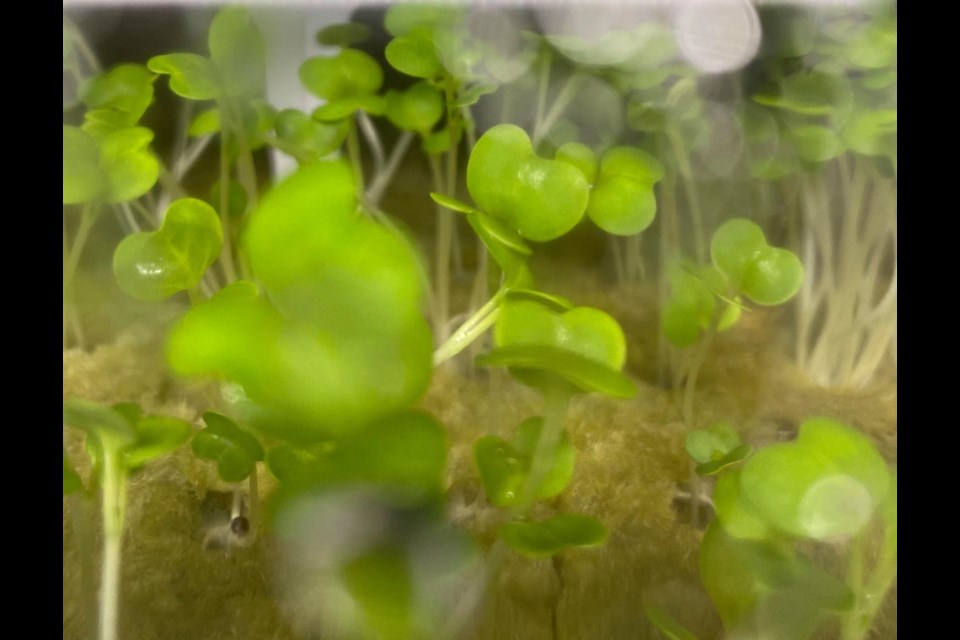Last February, April Folz was attending a conference in Québec with a team from Sheshegwaning First Nation when a tradeshow display caught her eye.
It was unusual to see shoots of fresh, edible greens in amongst the displays, especially at that time of year, but there they were, at an exhibit for The Growcer, an Ottawa-based company that develops hydroponic container farms.
“It was winter, and it was snowing,” recalled Folz, Sheshegwaning’s economic development director. “It was so neat that it was growing in the middle of winter – there were snowstorms.”
The community’s interest in the farming system was piqued but wasn’t given any serious consideration until a few weeks later, Folz recalled.
When COVID-19 arrived in Northern Ontario in March, members of the outlying community, which is situated on the far west end of Manitoulin Island, began to worry about food chains being interrupted and how they would continue to enjoy a supply of fresh produce when the nearest grocery store is about 45 minutes away in Gore Bay.
Fears were further exacerbated with talk of closing off access to the swing bridge at Little Current, which, during the winter months, provides the sole route on and off the island that’s situated in the upper end of Georgian Bay in Lake Huron.
“This pandemic happened and people were complaining that they couldn't get anything at the grocery store, and they couldn't get any of the fresh produce in at the store here (in Sheshegwaning),” Folz said.
“We were having a hard time supplying that for our people.”
The community of 118 quickly made a decision to take the plunge into container farming, taking out a loan to purchase their very own Growcer farm, and the unit arrived in the community on June 22.
Launched in 2015, The Growcer adheres to other models of container farming that start with a shipping container and add hydroponic growing equipment and LED lights to create a self-contained, closely monitored system that allows for growing year-round.
Seeds are nurtured with a tailored combination of nutrients, water and lighting, and crops are ready to be harvested after about four to six weeks. With a staggered planting system in place, crops are always growing.
If something goes wrong – the temperature gets too high, for example – the sophisticated monitoring system will alert staff through their phones so they can visit the farm and adjust accordingly.
“Growcer also has access to our system,” Folz said. “So they get alarms as well, and they can regulate it from Ottawa.”
The company provides full training and ongoing support as part of the purchase agreement.
There are even some job opportunities for those enterprising community members with an interest in agriculture.
Folz is currently hiring for a full-time systems manager, who will be responsible for planting and harvesting, cleaning, and calibrating the Growcer system, as well as two part-timers, who will help with monitoring the crops.
Growcer farms are now successfully producing fresh greens every week in communities as farflung as Kugluktuk, Nunavut, and Churchill, Man.
Conditions in Sheshegwaning aren’t nearly as harsh or rugged as in those more remote regions, but the arrival of their own container farm has generated buzz amongst the many avid salad-eaters in the community.
For $10 a week, residents who want a take of the harvest sign up for a subscription box, which guarantees them five heads of greens of their choice delivered to their door. A portion of the harvest will also go to local business Mkwa Catering for use in their dishes.
The first seeds were planted during the week of July 20, and Folz expects to reap the harvest in mid-August. Products will be marketed under the Odawa Freshwater brand.
She’s calculated that if they sell out weekly, the community will break even on its loan for the project.
So far, the community has planted Monte Carlo romaine lettuce, red Russian lettuce, Tuscan kale, wildfire lettuce, and win win choi, along with basil, parsley and mint.
“People want spinach, so they’re going to send us some spinach seeds and get that going,” Folz noted.
Folz said 450 heads of greens will be harvested weekly, while the herbs can be cut back each week and will self-replenish until they reach the end of their lifecycle, which she estimates will be some time in October.
An ongoing experiment with different lighting and growing conditions aims to see if there's any success with strawberries.
Known in many Indigenous cultures as the “heart berry,” strawberries are celebrated as a marker of spring, help promote health and well-being, and signify friendship and reconciliation.
“Strawberries are very important for Native culture for ceremonies, and it would be fantastic to get them fresh year-round if we could do that,” Folz said.
“This (container) is specific for greens, and it will probably stay that way. Maybe down the road we’ll get one for strawberries.”




